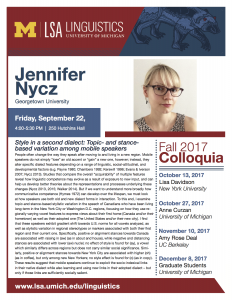Presented By: Department of Linguistics
Linguistics Colloquium: Style in a second dialect: Topic- and stance-based variation among mobile speakers
Jennifer Nycz, Georgetown University

Style in a second dialect: Topic- and stance-based variation among mobile speakers
People often change the way they speak after moving to and living in a new region. Mobile speakers do not simply "lose" an old accent or "gain" a new one, however; instead, they alter specific dialect features depending on a range of linguistic, social-attitudinal, and developmental factors (e.g. Payne 1980; Chambers 1992; Kerswill 1996; Evans & Iverson 2007; Nycz 2013). Studies that compare the overall “acquirability” of multiple features reveal how linguistic competence may evolve as a result of exposure to new input, and can help us develop better theories about the representations and processes underlying these changes (Nycz 2013, 2015; Walker 2014). But if we want to understand more broadly how communicative competence (Hymes 1972) can develop over the lifespan, we must look at how speakers use both old and new dialect forms in interaction. To this end, I examine topic-and stance-based stylistic variation in the speech of Canadians who have been living long-term in the New York City or Washington D.C. regions, focusing on how they use regionally varying vowel features to express views about their first home (Canada and/or their hometown) as well as their adopted one (The United States and/or their new city). I find that these speakers exhibit gradient shift towards U.S. norms for all vowels analyzed, as well as stylistic variation in regional stereotypes or markers associated with both their first region and their current one. Specifically, positive or alignment stances towards Canada are associated with raising in (aw) (as in about and house), while negative and distancing stances are associated with lower (aw) nuclei; no effect of style is found for (ay), a vowel which similarly differs across regions but does not carry similar social significance. Similarly, positive or alignment stances towards New York City are associated with higher (oh) (as in coffee), but only among new New Yorkers; no style effect is found for (o) (as in copy). These results suggest that mobile speakers continue to exploit the socio-indexical links in their native dialect while also learning and using new links in their adopted dialect – but only if those links are sufficiently socially salient.
People often change the way they speak after moving to and living in a new region. Mobile speakers do not simply "lose" an old accent or "gain" a new one, however; instead, they alter specific dialect features depending on a range of linguistic, social-attitudinal, and developmental factors (e.g. Payne 1980; Chambers 1992; Kerswill 1996; Evans & Iverson 2007; Nycz 2013). Studies that compare the overall “acquirability” of multiple features reveal how linguistic competence may evolve as a result of exposure to new input, and can help us develop better theories about the representations and processes underlying these changes (Nycz 2013, 2015; Walker 2014). But if we want to understand more broadly how communicative competence (Hymes 1972) can develop over the lifespan, we must look at how speakers use both old and new dialect forms in interaction. To this end, I examine topic-and stance-based stylistic variation in the speech of Canadians who have been living long-term in the New York City or Washington D.C. regions, focusing on how they use regionally varying vowel features to express views about their first home (Canada and/or their hometown) as well as their adopted one (The United States and/or their new city). I find that these speakers exhibit gradient shift towards U.S. norms for all vowels analyzed, as well as stylistic variation in regional stereotypes or markers associated with both their first region and their current one. Specifically, positive or alignment stances towards Canada are associated with raising in (aw) (as in about and house), while negative and distancing stances are associated with lower (aw) nuclei; no effect of style is found for (ay), a vowel which similarly differs across regions but does not carry similar social significance. Similarly, positive or alignment stances towards New York City are associated with higher (oh) (as in coffee), but only among new New Yorkers; no style effect is found for (o) (as in copy). These results suggest that mobile speakers continue to exploit the socio-indexical links in their native dialect while also learning and using new links in their adopted dialect – but only if those links are sufficiently socially salient.